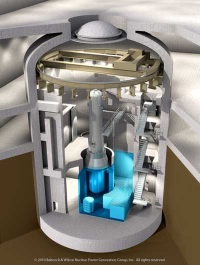B&W, Bechtel team up on mPower
 Babcock & Wilcox (B&W) and Bechtel have entered into a formal alliance to design, license and deploy B&W's mPower reactor design. B&W announced plans for the 125 MWe modular nuclear power reactor in June 2009.
Babcock & Wilcox (B&W) and Bechtel have entered into a formal alliance to design, license and deploy B&W's mPower reactor design. B&W announced plans for the 125 MWe modular nuclear power reactor in June 2009.Babcock & Wilcox (B&W) and Bechtel have entered into a formal alliance to design, license and deploy B&W's mPower reactor design. B&W announced plans for the 125 MWe modular nuclear power reactor in June 2009.
 |
| Cutaway of a single mPower module inside its own independent, underground containment (Image: B&W) |
The mPower is an integral PWR designed to be factory-made and railed to site. The reactor pressure vessel containing core and steam generator is thus only a few metres in diameter. It will have a "conventional core and standard fuel" enriched to 5%, presumably with burnable poisons, to give a five-year operating cycle between refuelling. This is intended to provide a low-cost approach to plant operations. B&W notes that nuclear security and near-term management of used fuel would be improved through the underground containment design that will store fuel for the planned 60-year life of the plant.
When announcing the design, B&W said that the "scalable nature of nuclear power plants built around the B&W mPower reactor would provide customers with practical power increments of 125 MWe to meet local energy needs within power grid and plant site constraints." Several units would be combined into a power station of any size, but most likely 500-750 MWe and using 250 MWe turbine generators, constructed in three years.
Under the new alliance - to be known as Generation mPower - B&W will focus on designing and testing the nuclear steam supply system (NSSS) and nuclear island, including the design certification application development and submission, and NSSS production. Bechtel will complement these responsibilities with integrated engineering and project management leadership.
Chris Mowry, president of B&W Nuclear Energy, said: "The formation of our Generation mPower alliance demonstrates a new level of commitment by American industry to address the growing challenge of climate change in an economical and practical way with small modular reactor technology. It brings together industry leaders in the areas of nuclear technology, manufacturing and construction."
He added, "We believe that Generation mPower positions us to collectively deliver greater certainty in nuclear project cost and schedule, which are necessary to enable broader, more timely deployment of nuclear power."
Jack Futcher, president of Bechtel's power business commented: "The formation of Generation mPower is a turning point in the nuclear power plant industry - it has the potential to be a real game changer."
He said, "This alliance intends to advance the development and deployment of nuclear power in a way that makes nuclear power more accessible to utilities and more affordable to consumers. Bechtel brings the plant engineering, procurement and construction capability to complement B&W's expertise in nuclear engineering and manufacturing. Together, we have the resources, experience and expertise to deliver on the promise of a new clean energy option."
A memorandum of understanding was signed last year by B&W, Tennessee Valley Authority (TVA) and a consortium of regional municipal and cooperative utilities to explore the construction of a fleet of mPower reactors to meet the consortium's need to diversify its power generation assets.
In a joint statement, B&W and Bechtel said, "Depending on regulatory approval and other factors, the first plant could be deployed as early as 2020."
Researched and written
by World Nuclear News
_92619.jpg)

_84504.jpg)







_88592.jpg)

